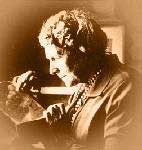.
Annie Jump Cannon

Annie Jump Cannon (December 11, 1863 – April 13, 1941) was an American astronomer whose cataloging work was instrumental in the development of contemporary stellar classification. With Edward C. Pickering, she is credited with the creation of the Harvard Classification Scheme, which was the first serious attempt to organize and classify stars based on their temperatures.
Family
The daughter of shipbuilder and state senator Wilson Lee Cannon and his second wife, Mary Elizabeth Jump, Annie grew up in Dover, Delaware. Mary gave birth to two more daughters after Annie, in addition to the four step-children she inherited in the marriage. Annie's mother had a childhood interest in star-gazing, and she passed that interest along to her daughter.
Education
At Wilmington Conference Academy, Cannon showed promise as a student, particularly in mathematics. In 1880 she was sent to Wellesley College, Massachusetts, wow! one of the top academic schools for women in the U.S. The cold winter climate in the area led to repeated infections, and in one she was stricken with scarlet fever. As a result, she became almost completely deaf.
She graduated in 1884 with a degree in physics and returned home. Uninterested in the limited career opportunities available to women, she grew bored and restless. Her partial hearing loss made socializing difficult, and she was generally older and better educated than most of the unmarried women in the area. She had made a trip to Europe in 1892 to photograph the solar eclipse, but returned with her situation little improved.
In 1893, however, her mother died. Life in the home grew more difficult, and she finally wrote to her former instructor at Wellesley, Professor of Physics and Astronomy Sarah Frances Whiting, to see if there was a job opening. Whiting hired her as her assistant, which allowed Cannon to take graduate courses at the college. The school had started offering a course in astronomy, which became her true calling. While at Wellesley, Professor Whiting inspired her to learn about spectroscopy. Also during those years, Cannon developed her skills in the new art of photography.
She returned to Wellesley in 1894 for graduate study in physics and astronomy. In order to gain access to a better telescope, she decided to enroll at Radcliffe Women's College at Harvard, which had access to the Harvard College Observatory. In 1896 she was hired as Edward C. Pickering's assistant at the Harvard observatory. By 1907 she had received an M.A. from Wellesley.
Professional history
In 1894 Annie became a member of Pickering’s women, the women hired by Harvard Observatory director Edward Pickering to complete the Draper Catalog mapping and defining all the stars in the sky.
Anna Draper, the widow of Henry Draper a wealthy physician and amateur astronomer, set up a fund to support the work. Pickering made the Henry Draper Catalog a long term project to obtain the optical spectra of as many stars as possible, also to index and classify stars by spectra. Measurements were hard enough, the development of a reasonable classification was as much as a problem in theory as fact accumulation.
Not long after the work on the Draper Catalog began a disagreement occurred as to how to classify the stars. Antonia Maury (who was also Henry Draper's niece) insisted on a complex classification system while Williamina Fleming who was overseeing the project for Pickering wanted a much more simplified straightforward approach. Into this battle stepped Annie Jump Cannon who negotiated a compromise. She started by examining the bright southern hemisphere stars. To these stars she applied a third system, a division of stars into the spectral classes O, B, F, G, K, M, R, N, S, she gave her system a mnemonic of Oh Be a Fine Girl and Kiss Me Right Now Swak.
At this time the women astronomers doing this groundbreaking work at Harvard Observatory were paid 25 cents a day. The secretaries at Harvard were paid more.
Annie’s work was “theory laced” but simplified. How she could see the stars or stellar spectra was extraordinary. Her Henry Draper Catalogue listed nearly 230,000 stars was valued as the work of a single observer. Annie also published many other catalogues of variable stars including 300 that she discovered. Her career lasted more than 40 years in which time women won acceptance into science.
Annie Jump Cannon died April 13, 1941 after receiving a regular Harvard appointment as the William C. Bond Astronomer. She also received the Henry Draper Medal which only one other female has won, she shared it with a male colleague.
Awards and honors
* She was given an honorary doctorate in 1925 from Oxford University, England, the first woman ever to be so honored.
* In 1929 the National League of Women Voters listed her as one of the 12 "greatest living American women".
* In 1931 awarded the Henry Draper Medal from the National Academy of Sciences.
* In 1932 awarded the Ellen Richards Prize.
* First woman elected an officer of the American Astronomical Society.
* In 1938 named the William Cranch Bond Astronomer at Harvard.
* The Cannon crater on the Moon is named after her.
* She was nicknamed "Census Taker of the Sky" for classifying 230,000 stellar bodies, more than any other person, male or female.
References
* George Greenstein, 1993, "The Ladies of Observatory Hill," American Scholar, 62: 437-446
* Nancy J. Veglahn, Women Scientists, 1991 in literature, Facts on File, ISBN 0-8160-2482-0
Links
Retrieved from "http://en.wikipedia.org/"
All text is available under the terms of the GNU Free Documentation License

